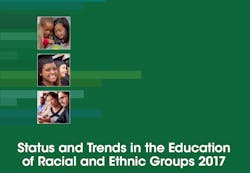U.S. school population is becoming less white, less black
The makeup of school children in the United States in the 21st century is becoming more Hispanic, more Asian, less black and less white.
A new data report from the National Center for Education Statistics (NCES), "Status and Trends in the Education of Racial and Ethnic Groups, 2017," states that between 2000 and 2016, the percentage of school age children in the nation who are white has dropped from 62 percent to 52 percent; the percentage of students who are black has declined from 15 percent to 14 percent.
Meanwhile, the percentage of students who are Hispanic has jumped significantly over those same years—from 16 percent to 25 percent. Students who are Asian also claim a larger percentage—5 percent in 2016, compared with 3 percent in 2000. The percentage of students who claim two or more races also has increased—from 2 percent in 2000 to 4 percent in 2016.
"Measuring population growth and diversity is important for anticipating the needs of schools and teachers," the NCES report says. "An awareness of the shifting demographics of the U.S. population can help ensure that educators are prepared to work with diverse groups of students."
Looking more specifically at enrollment in public elementary and secondary schools, the NCES found similar trends among racial categories. Between 2003 and 2013, the percentage of public school students who are white dropped from 59 percent to 50 percent, and the percentage of students who are black declined from 17 percent to 16 percent. The percentage of students who are Hispanic rose during that decade from 19 to 25; and the percentage of students who are Asian increase from 4 to 5.
The report includes projections indicating those trends will continue over the next decade. In 2025, the percentage of public school students who are white is projected to fall to 46 percent; the percentage of students who are black will decline slightly to 15 percent. Hispanic students are projected to make up 29 percent of the public school population, and students who are Asian or Pacific Islander are projected to make up 6 percent of school enrollment.
Overall, the report says, the United States had 53.8 million children in 2016 between the ages of 5 and 17—the range that the NCES considers school-age.
The report also provides a breakdown of children under the age of 18 in families living in poverty. In 2014, 12 percent of white, 12 percent of Asian, 31 percent of Hispanic and 37 percent of black children were in families living in poverty.
About the Author
Mike Kennedy
Senior Editor
Mike Kennedy, senior editor, has written for AS&U on a wide range of educational issues since 1999.
